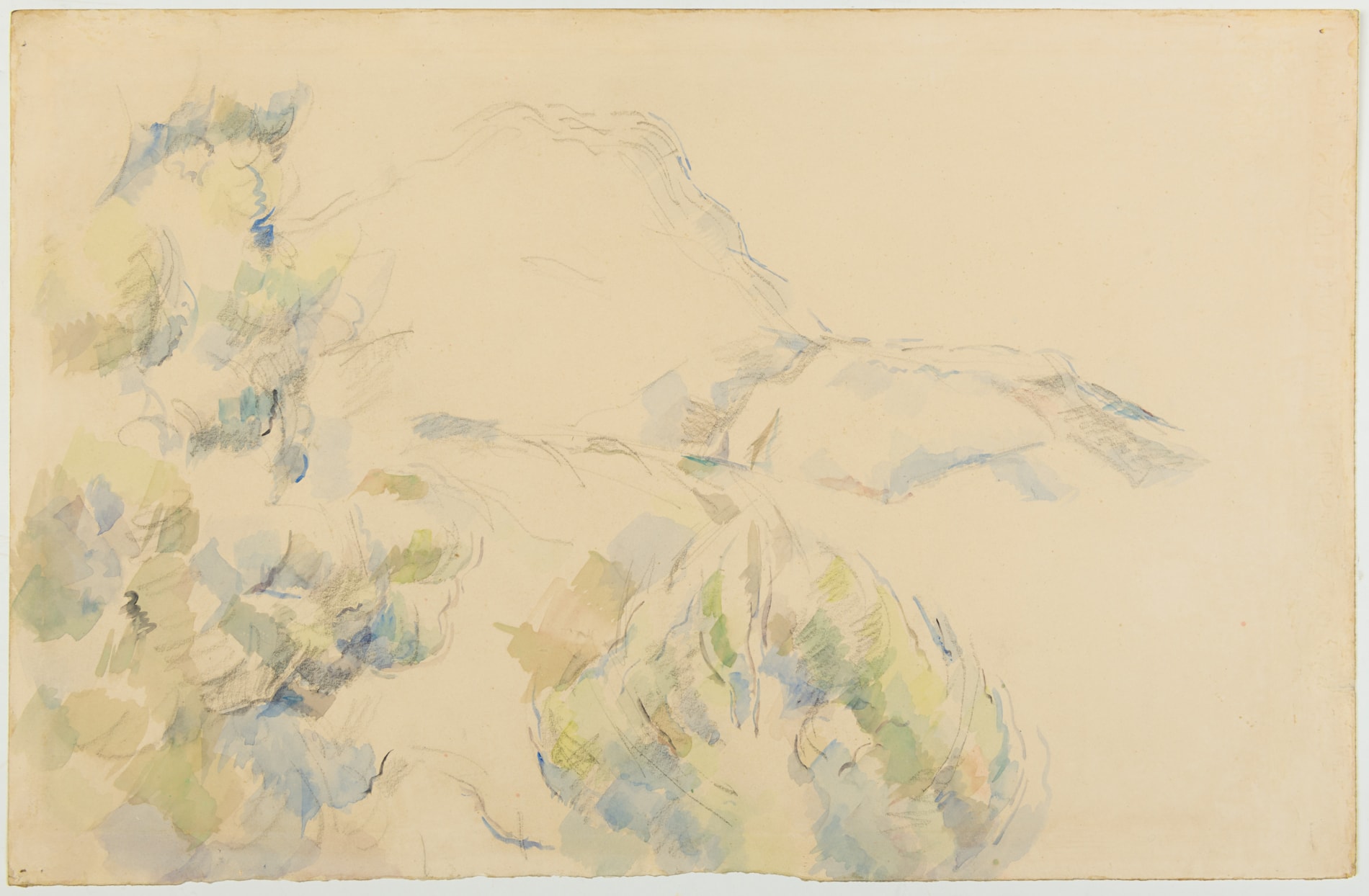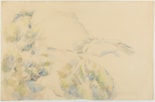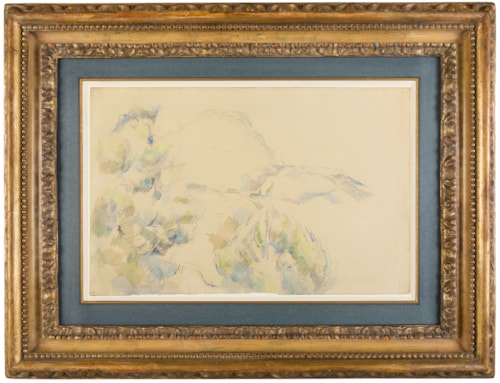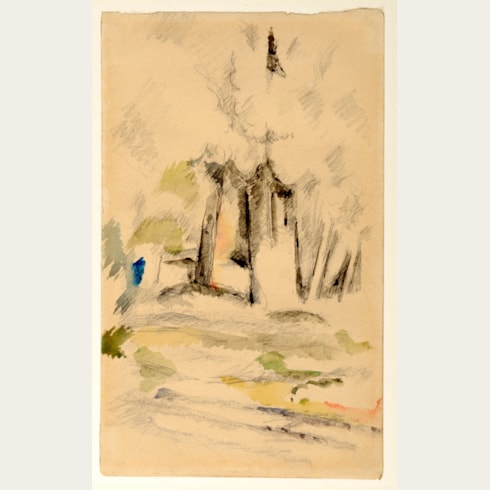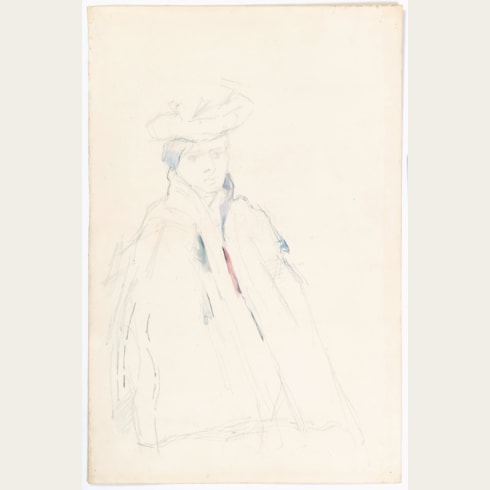Paul CEZANNE
(Aix-en-Provence 1839 - Aix-en-Provence 1906)
Landscape with the Montagne Saint-Victoire
Sold
Watercolour and pencil on white wove paper.
Inscribed (in a modern hand) haut / arbres devant la montagne in pencil on the verso.
Numbered 164 / 16975 on the verso.
325 x 499 mm. (12 3/4 x 19 5/8 in.)
Inscribed (in a modern hand) haut / arbres devant la montagne in pencil on the verso.
Numbered 164 / 16975 on the verso.
325 x 499 mm. (12 3/4 x 19 5/8 in.)
East of Aix-en-Provence and dominating the surrounding plain, the mountain known as Mont Sainte-Victoire rises to over 3,000 feet. Paul Cézanne painted more than thirty oil paintings and some forty-five watercolours of the mountain, from different vantage points, and it was a motif that he returned to often throughout his later life. As Lionello Venturi has written, ‘Mount Ste. Victoire, which is so isolated and imposing when seen from around Aix, was perhaps the thing in nature which most fascinated Cézanne from boyhood. Whenever he climbed it, he regained his contact with nature – a nature of wide horizons.’ The bare, rocky peak of the mountain was to be an endless source of fascination for the artist.
Most of Cézanne’s paintings of Mont Sainte-Victoire can be divided into two distinct periods of his career; between 1882 and 1890, and again between 1901 and his death in 1906. The present watercolour is part of the last, and perhaps the most important, series of studies that Cézanne painted of this inspirational view. As the artist himself is said to have noted to his close friend Joachim Gasquet, ‘Look at Sainte-Victoire there. How it soars, how imperiously it thirsts for the sun! And how melancholy in the evening when all its weight sinks back…For a long time I was quite unable to paint Sainte-Victoire; I had no idea how to go about it because, like others who just look at it, I imagined the shadow to be concave, whereas in fact it’s convex, it disperses outward from the centre. Instead of accumulating, it evaporates, becomes fluid, bluish, participating in the movements of the surrounding air.’
This large watercolour may be related to an oil painting by Cézanne of Mont Sainte-Victoire of c.1904-1906, of vertical format, in the Detroit Institute of Arts. It is also close in composition to another painting by Cézanne of c.1904, Mont Sainte-Victoire above the Route du Tholonet in the Cleveland Museum of Art, which is of a square format.
In his critical catalogue raisonné of Cézanne’s watercolours, John Rewald has noted that this watercolour Landscape with the Montagne Saint-Victoire differs in mood from the related painting in Detroit: ‘What contributes to this different mood is that for the painting Cézanne had adopted a vertical format, whereas in this watercolor the more “congenial” horizontal composition allows the motif to breathe more freely. The motif seems to have been painted from the vicinity of the terrace of Château Noir. Pale washes, predominantly blue and green, are applied over a very light pencil sketch. The outlines of the mountain, however, have been redrawn several times with the pencil and then delicately retraced with a thin blue brush line.’
As has been noted of the present sheet, ‘This representation of the Sainte-Victoire is unusual among Cézanne’s numerous paintings of the subject by virtue of the thin, disappearing line with which the mountain is drawn. Ordinarily the painter’s bold brushstrokes force the mountain to loom heavy in the background. But in this example, two trees with wide areas of color dominate the view; there is no middle ground filled with the details of houses and trees. A floating, moving atmosphere is created by the fluidity of the medium and by the large blank areas on the paper. An oil painting of the same subject, done about 1897, gives an almost identical view but with an entirely different mood, devoid of the air, transparency, and movement of our drawing.’
As pointed out by the Cézanne scholar John Rewald,‘The brushwork of the late watercolors is bold and large, superbly fluent and self-assured…Sometimes there are hasty and vague pencil indications that establish basic shapes and guide the brush through intricate panoramas of fields and trees, buildings and curved roads, rocks and branches, not to mention the crags of Mont Saint-Victoire. But frequently the preparatory sketch is completely dispensed with and the brush attacks the paper directly, spreading its multicolored touches with a breathtaking – one might say meditated and controlled – spontaneity, accumulating transparent veils from which forms disengage themselves and assert their identity by contrast with the whiteness of the support…In a strange dialectic, the profile of Saint-Victoire, seen from Les Lauves, is honed to its essentials while the radiant washes that surround it leave all details vague.’ More recently, another scholar has observed that, ‘in these watercolors of Montagne Sainte-Victoire, the bright, exposed paper captures something of the blinding intensity of the light of the south of France.’
This Landscape with the Montagne Saint-Victoire was one of several watercolours by Cézanne that were exhibited at the first ‘Secessione’ exhibition in Rome in 1913, when the artist’s work as a watercolourist was still little-known. It was purchased three years later by Lillie P. Bliss (1864-1931), one of the earliest American collectors of Cézanne’s paintings and watercolours. Bliss acquired her first work by Cézanne in 1913, and continued to purchase works by the artist almost to the end of her life. Although she made annual visits to Europe in the 1920s, she seems to have acquired almost everything in her collection from art dealers in New York. The present sheet was one of eight watercolours purchased by Bliss at the Cézanne exhibition held at the Montross Gallery in New York in 1916, which had been selected and curated by Félix Fénéon of the Galerie Bernheim-Jeune in Paris.
In 1931 Bliss bequeathed much of her collection to the nascent Museum of Modern Art in New York, which she had helped to found, and this watercolour entered the museum’s collection in 1934. While Bliss’s bequest of 150 works became the nucleus of the collection of the Museum of Modern Art, she had stipulated in her will that any of the works (with the exception of two paintings by Cézanne and one by Honoré Daumier) could be sold or exchanged for other works of art to help strengthen the young museum’s collection. The present sheet was deaccessioned by the museum in 1944, and was immediately acquired by the banker and prominent art collector Siegfried Kramarsky (1893-1961), who owned several important paintings by Vincent Van Gogh, as well as works by Cézanne, Paul Gauguin, Auguste Renoir, Georges Seurat and many others. Landscape with the Montagne Saint-Victoire remained in the possession of Kramarsky and his descendants for the next seventy-five years, and was last exhibited in 1967.
The artist’s early biographer Georges Rivière has noted that, ‘In their transparency, Cézanne’s watercolors call to mind the sumptuous stained-glass windows that once decorated the aisles of dark cathedrals and gave so much richness to the naves they illuminated with a flamboyant glow. These watercolors give off light, it seems, as if the sun had penetrated them.’ Furthemore, as Meyer Schapiro has perceptively noted, ‘It is one of the charms and also a mystery of the arts commonly grouped under the name of painting that a few pencil lines with some added washes of color, hardly filling the surface and made as a preliminary study for what is to be a fully-covered canvas, can possess an intrinsic completeness…We do not have to interest ourselves in the workshop procedure of Cézanne to enjoy these offshoots of his process. Our admiration is independent of curiosity about method and technique, so compelling is the harmony of these incidental stages of his work, a harmony which is not to be confused with the values of an unfinished canvas. These modest notes achieve wholeness through the same operations of choice and perfected habit that determine the order of the most complex composition. Unlike the unfinished picture they say what they were meant to say – if only to the painter himself – and although a watercolor could have said more, they seem to us a perfect achievement as they are.’
Most of Cézanne’s paintings of Mont Sainte-Victoire can be divided into two distinct periods of his career; between 1882 and 1890, and again between 1901 and his death in 1906. The present watercolour is part of the last, and perhaps the most important, series of studies that Cézanne painted of this inspirational view. As the artist himself is said to have noted to his close friend Joachim Gasquet, ‘Look at Sainte-Victoire there. How it soars, how imperiously it thirsts for the sun! And how melancholy in the evening when all its weight sinks back…For a long time I was quite unable to paint Sainte-Victoire; I had no idea how to go about it because, like others who just look at it, I imagined the shadow to be concave, whereas in fact it’s convex, it disperses outward from the centre. Instead of accumulating, it evaporates, becomes fluid, bluish, participating in the movements of the surrounding air.’
This large watercolour may be related to an oil painting by Cézanne of Mont Sainte-Victoire of c.1904-1906, of vertical format, in the Detroit Institute of Arts. It is also close in composition to another painting by Cézanne of c.1904, Mont Sainte-Victoire above the Route du Tholonet in the Cleveland Museum of Art, which is of a square format.
In his critical catalogue raisonné of Cézanne’s watercolours, John Rewald has noted that this watercolour Landscape with the Montagne Saint-Victoire differs in mood from the related painting in Detroit: ‘What contributes to this different mood is that for the painting Cézanne had adopted a vertical format, whereas in this watercolor the more “congenial” horizontal composition allows the motif to breathe more freely. The motif seems to have been painted from the vicinity of the terrace of Château Noir. Pale washes, predominantly blue and green, are applied over a very light pencil sketch. The outlines of the mountain, however, have been redrawn several times with the pencil and then delicately retraced with a thin blue brush line.’
As has been noted of the present sheet, ‘This representation of the Sainte-Victoire is unusual among Cézanne’s numerous paintings of the subject by virtue of the thin, disappearing line with which the mountain is drawn. Ordinarily the painter’s bold brushstrokes force the mountain to loom heavy in the background. But in this example, two trees with wide areas of color dominate the view; there is no middle ground filled with the details of houses and trees. A floating, moving atmosphere is created by the fluidity of the medium and by the large blank areas on the paper. An oil painting of the same subject, done about 1897, gives an almost identical view but with an entirely different mood, devoid of the air, transparency, and movement of our drawing.’
As pointed out by the Cézanne scholar John Rewald,‘The brushwork of the late watercolors is bold and large, superbly fluent and self-assured…Sometimes there are hasty and vague pencil indications that establish basic shapes and guide the brush through intricate panoramas of fields and trees, buildings and curved roads, rocks and branches, not to mention the crags of Mont Saint-Victoire. But frequently the preparatory sketch is completely dispensed with and the brush attacks the paper directly, spreading its multicolored touches with a breathtaking – one might say meditated and controlled – spontaneity, accumulating transparent veils from which forms disengage themselves and assert their identity by contrast with the whiteness of the support…In a strange dialectic, the profile of Saint-Victoire, seen from Les Lauves, is honed to its essentials while the radiant washes that surround it leave all details vague.’ More recently, another scholar has observed that, ‘in these watercolors of Montagne Sainte-Victoire, the bright, exposed paper captures something of the blinding intensity of the light of the south of France.’
This Landscape with the Montagne Saint-Victoire was one of several watercolours by Cézanne that were exhibited at the first ‘Secessione’ exhibition in Rome in 1913, when the artist’s work as a watercolourist was still little-known. It was purchased three years later by Lillie P. Bliss (1864-1931), one of the earliest American collectors of Cézanne’s paintings and watercolours. Bliss acquired her first work by Cézanne in 1913, and continued to purchase works by the artist almost to the end of her life. Although she made annual visits to Europe in the 1920s, she seems to have acquired almost everything in her collection from art dealers in New York. The present sheet was one of eight watercolours purchased by Bliss at the Cézanne exhibition held at the Montross Gallery in New York in 1916, which had been selected and curated by Félix Fénéon of the Galerie Bernheim-Jeune in Paris.
In 1931 Bliss bequeathed much of her collection to the nascent Museum of Modern Art in New York, which she had helped to found, and this watercolour entered the museum’s collection in 1934. While Bliss’s bequest of 150 works became the nucleus of the collection of the Museum of Modern Art, she had stipulated in her will that any of the works (with the exception of two paintings by Cézanne and one by Honoré Daumier) could be sold or exchanged for other works of art to help strengthen the young museum’s collection. The present sheet was deaccessioned by the museum in 1944, and was immediately acquired by the banker and prominent art collector Siegfried Kramarsky (1893-1961), who owned several important paintings by Vincent Van Gogh, as well as works by Cézanne, Paul Gauguin, Auguste Renoir, Georges Seurat and many others. Landscape with the Montagne Saint-Victoire remained in the possession of Kramarsky and his descendants for the next seventy-five years, and was last exhibited in 1967.
The artist’s early biographer Georges Rivière has noted that, ‘In their transparency, Cézanne’s watercolors call to mind the sumptuous stained-glass windows that once decorated the aisles of dark cathedrals and gave so much richness to the naves they illuminated with a flamboyant glow. These watercolors give off light, it seems, as if the sun had penetrated them.’ Furthemore, as Meyer Schapiro has perceptively noted, ‘It is one of the charms and also a mystery of the arts commonly grouped under the name of painting that a few pencil lines with some added washes of color, hardly filling the surface and made as a preliminary study for what is to be a fully-covered canvas, can possess an intrinsic completeness…We do not have to interest ourselves in the workshop procedure of Cézanne to enjoy these offshoots of his process. Our admiration is independent of curiosity about method and technique, so compelling is the harmony of these incidental stages of his work, a harmony which is not to be confused with the values of an unfinished canvas. These modest notes achieve wholeness through the same operations of choice and perfected habit that determine the order of the most complex composition. Unlike the unfinished picture they say what they were meant to say – if only to the painter himself – and although a watercolor could have said more, they seem to us a perfect achievement as they are.’
Provenance
The estate of the artist
By inheritance to Paul Cézanne fils, Aix-en-Provence and Paris
Part of a group of watercolours acquired from him on 11 March 1907 by the Galerie Bernheim-Jeune et Cie., Paris
Sold by them on 1 April 1916 to Newman Emerson Montross (Montross Gallery), New York, for 2,800 FF
Acquired from them in 1916 by Lillie (Lizzie) P. Bliss, New York
Bequeathed by her in 1931 to the Museum of Modern Art, New York
Their sale, Parke-Bernet Galleries, New York, 11 May 1944, lot 65
Lola and Siegfried Kramarsky, New York
By descent to Dr. Sonja Binkhorst-Kramarsky, New York, by 1959
Thence by descent to a private collection, New York.
By inheritance to Paul Cézanne fils, Aix-en-Provence and Paris
Part of a group of watercolours acquired from him on 11 March 1907 by the Galerie Bernheim-Jeune et Cie., Paris
Sold by them on 1 April 1916 to Newman Emerson Montross (Montross Gallery), New York, for 2,800 FF
Acquired from them in 1916 by Lillie (Lizzie) P. Bliss, New York
Bequeathed by her in 1931 to the Museum of Modern Art, New York
Their sale, Parke-Bernet Galleries, New York, 11 May 1944, lot 65
Lola and Siegfried Kramarsky, New York
By descent to Dr. Sonja Binkhorst-Kramarsky, New York, by 1959
Thence by descent to a private collection, New York.
Literature
Alfred H. Barr, Jr., ed., The Lillie P. Bliss Collection, exhibition catalogue, New York, 1934, p.35, no.17, pl.17; Lionello Venturi, Cézanne: Son art - son oeuvre, Paris, 1936, Vol.I, p.266, no.1018, Vol.II, pl.301, fig.1018 (where dated 1900-1906); Alfred H. Barr, Jr., ed., Painting and Sculpture in the Museum of Modern Art, New York, 1942, p.30 no.101; Theodore Reff, ‘Cézanne’s Watercolors and Modern Taste’, in Theodore Reff, ed., Cézanne Watercolors, exhibition catalogue, New York, 1963, p.16; Theodore Reff, ed., Cézanne Watercolors, exhibition catalogue, New York, 1963, pp.50-51, no.52, illustrated pl.LI (entry by Caroline Abraham); Alfred H. Barr, Jr., Painting and Sculpture in the Museum of Modern Art 1929-1967, New York, 1977, p.651; John Rewald, Paul Cézanne. The Watercolours: A Catalogue Raisonné, London and New York, 1983, p.209, no.499, illustrated fig.499 (where dated c.1900); George S. Keyes, ‘Reconsideration of Late Variants of Cézanne’s “Theme of Mont Sainte-Victoire”’, Bulletin of the Detroit Institute of Arts, 2003, p.36, fig.6; Guy-Patrice and Floriane Dauberville, Cezanne: Paul Cezanne chez Bernheim-Jeune, Paris, 2020, Vol.I, p.97 (installation photograph as exhibited in 1914), Vol.II, pp.986-987, no.352; Walter Feilchenfeldt, Jayne Warman and David Nash, The Paintings, Watercolors and Drawings of Paul Cézanne: An Online Catalogue Raisonné, [www.cezannecatalogue.com], no.FWN 1444 (where dated c.1900); Christopher Lloyd et al, Impressionists on Paper: Degas to Toulouse-Lautrec, exhibition catalogue, London, 2023-2024, pp.138-139, no.73; Jackie Wullschläger, ‘The world in motion and on paper’, Financial Times, 25-26 November 2023, p.14.
Exhibition
Rome, Palazzo dell’ Esposizione, Prima esposizione internazionale d’arte della Secessione, 1913, no.677; Possibly Paris, Galerie Bernheim-Jeune, Exposition Cézanne, 1914; Rome, Palazzo dell’ Esposizione, Seconda esposizione internationale d'arte della Secessione, 1914, no.24 (as Alberi in montagna); New York, Montross Gallery, Cézanne Exhibition, 1916, no.12 (as Trees on the Mountain); Philadelphia, Pennsylvania Academy of Fine Arts, Exhibition of Paintings and Drawings by Representative Modern Masters, 1920, no.55 (as Trees on a Mountain); New York, Brooklyn Academy of Arts and Sciences, Summer Exhibition of Modern French and American Painters, June-October 1926; New York, The Museum of Modern Art, Andover, Massachusetts, Addison Gallery of American Art, Phillips Academy, and Indianapolis, John Herron Art Institute, Memorial Exhibition: The Collection of the Late Miss Lizzie P. Bliss, May 1931-January 1932, no.20 (as Trees on a Mountainside); New York, The Museum of Modern Art, The Lillie P. Bliss Collection, 1934, no.17; Pittsburgh, Department of Fine Arts, Carnegie Institute, An Exhibition of Paintings, Drawings and Water Colors from the Lillie P. Bliss Collection, 1935, no.30; Chicago, The Arts Club of Chicago, Watercolors and Drawings from the Lillie P. Bliss Collection, 1935, no.3; Chicago, Art Institute of Chicago and New York, Metropolitan Museum of Art, Cézanne: Paintings, Watercolors & Drawings, 1952, no.114; The Hague, Gemeentemuseum, Paul Cézanne 1839-1906, June-July 1956, no.87; Aix-en-Provence, Pavillon de Vendôme, Exposition pour commémorer le cinquantenaire de la mort de Cézanne, July-August 1956, no.79; Zurich, Kunsthaus Zürich, Paul Cézanne, August-October 1956, no.138; New York, Wildenstein, Cézanne, 1959, no.82; New York, M. Knoedler and Company, Cézanne Watercolors, April 1963, no.52; Pasadena, Pasadena Art Museum, Cézanne Watercolors, 1967, no.30; London, Royal Academy, Impressionists on Paper: Degas to Toulouse-Lautrec, 2023-2024, no.73,

